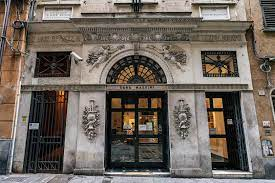Savouring the unexpected tastes of 19th-century history and cuisine
The new video release of the Outfood project is set in Genoa's Museo del Risorgimento. It investigates gourmand anecdotes related to three protagonists of 19th-century Italian history: Niccolò Paganini, Giuseppe Mazzini and Giuseppe Garibaldi.
Genoa, Liguria and the Risorgimento
The Istituto Mazziniano - Museo del Risorgimento is one of the several cultural tourism gems that visitors to Genoa should not overlook.
Based (since 1934) in Giuseppe Mazzini’s birthplace (via Lomellini 11),
the Museum belongs to the Istituto Mazziniano, with the archives and library.
It treasures documents, paintings, prints, flags, weapons, uniforms and
photographs.
The exhibition covers over 120 years of history - from the events
that led to the unification of Italy, such as the Genoese anti-Austrian revolt
in 1746 to the inauguration of the Monument to the Thousands of Quarto in 1915
and more. This bounty testifies to the central contribution of Genoa and Liguria
to the history of the Risorgimento: from its three great protagonists - Mazzini
and the republican and democratic movement, Garibaldi and the Red Shirts,
Goffredo Mameli and Italy's national Anthem, Fratelli d’Italia – to the many who
fought as volunteers in the wars for Italian independence and participated in
the Expedition of the Thousand.
The reconstruction of episodes comes alongside the tale of the
characters who literally made the Italian national identity, sometimes
sacrificing themselves without asking anything in return other than a destiny
of salvation for their homeland.
The exhibition also provides opportunities for a journey into the daily
life of those times, far or near depending on your point of observation and
sensitivity.
A new release of the "Outfood" project
A few weeks ago, Umberto Curti and I joined press officer Silvia Stefani
and video-maker Alessio Bixio – both from the Municipality of Genoa - at the
Istituto Mazziniano - Museo del Risorgimento. There, we met Museum Director
Elena Putti, who warmly welcomed us.
The reason for the visit was the shooting of the Italian and English
versions of the 6th video of the "Outfood, proud for its food and heritage" series. Designed by the GenovaWorld Association in collaboration with the
Municipality of Genoa, this project weaves together Genoa's cultural heritage
and events linked to culinary history, this latter being a recipient of an
array of 'stories'. The aim of “Outfood” is to strengthen the role of Genoa as
one of the capitals of Mediterranean food culture.
Have a taste of Paganini's ravioli, Mazzini's cake, and Garibaldi biscuits
There is a “foodie” fil rouge that links three of the most representative figures in Italian 19th-century history and culture: Niccolò Paganini (1782-1840), Giuseppe Mazzini (1805-1872) and Giuseppe Garibaldi (1807-1882).
Paganini's ravioli
The recipe for Paganini’s ravioli is treasured at the Library of Congress
in Washington. This 1839 autograph document details instructions for a rich
filling, a dough without eggs, and a hearty condiment: töccö alla zeneize.
Paganini's ravioli were the protagonists of another release of the Outfood
series, which we shot in the Sale Paganiniane in Palazzo Tursi – the seat of
the Municipality -, where the Guarneri del Gesù violin (a.k.a. il Cannone, the
cannon, on account of its powerful sound) is kept. Interestingly to note, the IN THE MUSE - Performing Arts at the Library of Congress blog features a
detailed recreation of the dish, inclusive of some adjustments to the American
palate.
Mazzini's cake
Almonds star in Mazzini's cake
La torta di Mazzini is a puff pastry cake, filled with a creamy,
sugary egg, almond and lemon zest filling. We get the information from a letter
that the politician and patriot wrote from Switzerland (where he lived as an
exile) to his mother in 1835, which is preserved here. Even though Mazzini put
forward a battery of disclaimers - “I do not know anything about cooking”; “I
translate as best I can…. what one of the girls told me in bad French”; “Do you
understand? God knows. You will tell me the results later: in the meantime,
laugh” – his gourmand drive was evident: “Before I forget myself, I want to
keep my promise. Here is the recipe I would like you to make and try because I
like it very much”.
Garibaldi biscuit
In 1864, after the Expedition of the Thousand and the Aspromonte, the
Hero of two Worlds was invited to London, where half a million people were
waiting for him, a sign that this crowd not only knew of his exploits but
adored him as an idealist and a valiant man.
Garibaldi biscuits were first made by Peek Freans, a biscuit company in
Bermondsey, which specialised in sea biscuits for sailors. To widen their
catalogue they co-opted Jonathan Dodgson Carr, who created the famous biscuit –
no-frill fare that would have suited Garibaldi’s simple tastes and frugal
palate.
The bottom line is... food is culture, and culture is
food.
The GenovaWorld association thanks colleagues, staff, and the Museum
Director for their welcome and cooperation. We are once again pleased to
contribute, with our own creative and operational commitment - and without
requesting any contribution -, to the promotion of Genoa in Italy and the
world. The name we have chosen is a telltale clue in itself...
Luisa Puppo, President of GenovaWorld and since 2018 HonoraryAmbassador of Genova in the World (AGW)
This is the fascinating world of tastes and crafts that LiguriabyLuisa discloses to foreign markets and buyers (tour operators, travel agencies, organizations, associations, food&wine dealers, and import/export professionals....).






Comments
Post a Comment